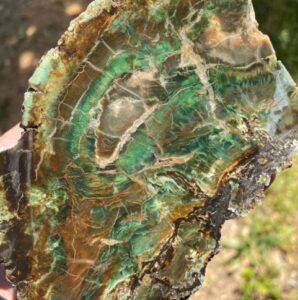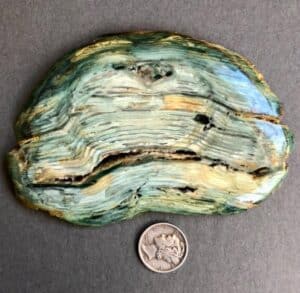Petrified wood gets its colors from various elements or compounds present when it forms. Over the years rockhounds and specimen collectors have favored green Petrified Wood because of its rarity.
Here’s a little background on how Petrified Wood forms just in case you didn’t know. Petrified wood is a type of fossilized wood that forms in several ways. While petrified wood can consist of different materials besides wood, it can maintain the same patterns and shapes as its past organic form. Petrified wood is also referred to as fossilized wood, with the difference being in how it forms.

Types of Green Petrified Wood
Like countless gemstones, the colors of petrified wood are caused by different minerals. For instance, the brown, red, and yellow colorations can be caused by iron oxides. Orange and pink hues can be produced by trace amounts of manganese. Blue and purple colors in petrified wood are caused by manganese dioxide. Various shades of green can be attributed to chromium, copper, iron, or cobalt.
Interestingly, petrified wood from Arizona can contain many colors in an individual specimen. The various colors are caused by different oxidation states of iron, which is the dominant colored element for petrified wood samples found in the state.
Green Petrified Wood Oregon
Petrified wood, especially Green Petrified Wood, is highly sought-after and can be found in Hampton Butte, Oregon. This area is widely known for its unique Green Petrified Wood, in addition to red, yellow, and a few other colors. Most of the surface collecting has petered out but fine specimens are still available for rockhounds ready to dig.
Oregon is home to various rocks, including Banded Agate and Jasper, with beautiful reddish hues and patterns. Geodes found in Oregon contain colorful crystals within and Thundereggs with a gray exterior. Obsidian and Opal are both located in the state as well.

Green Chromium Petrified Wood
Green chromium Petrified Wood is an incredibly rare type of Petrified Wood. If you’re looking to collect this type of Petrified Wood then you’ll want to plan a trip to Colorado. The high amounts of iron in the soil surrounding the wood cause green coloration over the years while fossilization occurs.
Green chromium Petrified Wood can also be found in a single deposit in Winslow, Arizona. This pocket was discovered during the 1970s, and they have determined that the pieces are over 180 million years old, which means they originate from the Triassic era.

Hampton Butte Green Petrified Wood
Hampton Butte is a popular collecting site for rockhounds interested in Green Petrified Wood. This 120-acre area is located 12 miles northeast of Highway 20, near the unincorporated community of Brothers.
The specimens found at Hampton Butte are gray, white, black, and yellow, with the most prized pieces ranging from turquoise to beautiful dark green colors. It is said that these colors are likely caused by copper or iron inclusions. The wood in this region appears as petrified wood or limb cases, where the original structures were replaced by Jasper, Common Opal, or Agate.

Gary Green Petrified Wood
This variety of Petrified Wood is known by several names, including Gary Green Jasper, Larsonite, McDermitt Bog Agate, and most recently, Caldera Jasper and Freedom Jasper.
Gary Green Petrified Wood is beautiful with its greenish layered and swirled materials formed when silica-rich fluids were filtered through Rhyolite ashes creating the beautiful colors we see today. Initially, the tight layering of the Rhyolite was believed to be Petrified Woods from a swamp containing many trees, algae, cattails, and other materials that had been buried by a volcanic occurrence over 12 million years ago. However, more recent research indicates that there isn’t any plant material present.
Green Petrified Wood Arizona
Arizona’s Green Petrified Wood is incredibly rare. It’s among the most famous and popular types of Petrified Wood worldwide. This variety of Petrified Wood comes from a tree fall in Winslow, Arizona, which is an area that reflects the presence of 2 percent or more Chromium in the specimen. It’s highly desired and sought-after by collectors.
The Green Petrified Woods in this region originates from the Chinle Formation, Triassic era, and it’s over 200 million years old. The specimen was once a living conifer tree that paleobotanists named Araucarioxylon Arizonicum, which is sadly now extinct. This species’ closest relatives are the Norfolk Island Pine and Monkey Puzzle Tree.
How Rare Is Green Petrified Wood?
Petrified wood is found in a variety of colors, but green is definitely considered rare on a worldwide scale. That said, the rarest color to this day is green.
Incredibly rare specimens of Green Petrified Woods have been found, and the presence of nickel may cause a beautiful green appearance in some locations. Other rare colors that have been found include blue and gold. Typical Petrified Woods has gorgeous beige, brown, and pink hues.
Petrified Wood is typically worth 25 cents per pound. Small specimens can cost between $2 to $4. However, rare varieties such as Green Petrified and Opalized Wood can cost much more. The rarer and more exotic a specimen is, the more it will be worth.
- Identify Enstatite - March 12, 2024
- Identify Cerussite - March 3, 2024
- Identify Bytownite - February 18, 2024

5 Responses
Truly interesting! I became an enthusiast at the young age of 5. I use to play in the art and science buildings at Cranbrook Institute in Bloomfield Hills Mi. They had an enormous collection there. I fell in love with them all❤️
You beat me by 3 years. I started when I was 8, collecting rocks in North Georgia.
Thanks for posting I grew up in Tucson to start collecting other specimens when I was about 16 before that people used to pay us for turquoise and copper specimens that we dug out of the slack piles at the mines
I like your articles you post on different minerals. I m from alaska,northern region where I live have a vast array of mineralized rocks.We have several hots springs that contribute to different types of minerals. Also fossilized trees and coral plants.
Thanks Morris and nice to meet you